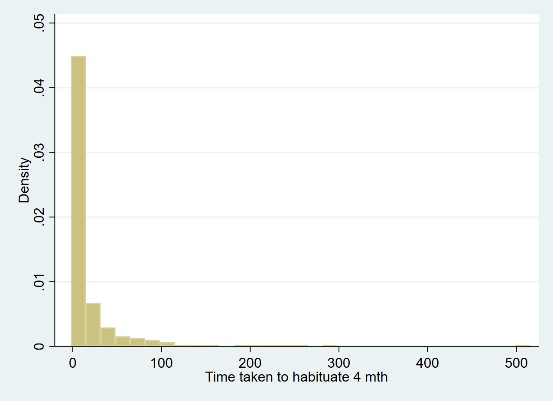The Avon Longitudinal Study of Parents and Children (ALSPAC) assessed their cohort members (CMs) at 4 months’ age (Children in Focus Clinic) using the Habituation Task.
Details on this measure and the data collected from the CMs are outlined in the table below.
| Domain: | Non-verbal; Habituation |
| Measures: | Correlates with later general ability |
| CHC: | None |
| Administration method: | Trained interviewer; clinical setting; physical task (eye-tracking) |
| Procedure: | Habituation refers to the extent to which attention directed towards a stimulus lessens over time. Research in this area works on the assumption that the amount of time an infant spends looking at a non-threatening stimulus before losing attention reflects speed of information processing. In other words, a child that 'habituates' to (i.e. loses interest in) a stimulus quickly is thought to be more efficient at processing information, compared with a child that takes a long time to lose interest in a stimulus. Habituation has been shown to correlate with later general ability (McCall & Carriger, 1993). During the task, the infant sat on the lap of the researcher, 18" away from a computer screen that projected a picture of four diamonds. The eye movements of the infants were tracked, and 'habituation' was reached when two successive 'bouts' of looking at the stimulus were shorter than the two previous 'bouts'. The infant was then presented with the same image alongside a new image, until s/he spent a total of 40 seconds looking at both (novelty preference). |
| Link to questionnaire: | http://www.bristol.ac.uk/alspac/researchers/our-data/clinical-measures/ (opens in new tab) |
| Scoring: | Seconds taken to habituate (3.6 - 515.1) |
| Item-level variable(s): | cf700 - cf719 |
| Total score/derived variable(s): | cf701 |
| Descriptives: | Time taken to habituate |
| N = 1,432 | |
| Range = 3.6 - 515.1 | |
| Mean = 12.62 | |
| SD = 34.91 | |
(click image to enlarge) |
|
| Age of participants: | Mean = 16.61 weeks, SD = 0.79, Range = 15-21 |
| Other sweep and/or cohort: | None |
| Source: | Designed specifically for ALSPAC by Dr Alan Slater, Department of Psychology, University of Exeter, UK, and by Dr Marc Bornstein, NICHD, USA. |
| Technical resources: | None |
| Reference examples: | Bornstein, M. H., Hahn, C. S., Bell, C., Haynes, O. M., Slater, A., Golding, J., ... & ALSPAC Study Team. (2006). Stability in cognition across early childhood: A developmental cascade. Psychological Science, 17(2), 151-158. |
| Bornstein, M. H., Hahn, C. S., & Wolke, D. (2013). Systems and cascades in cognitive development and academic achievement. Child Development, 84(1), 154-162. |
For the named items in the table above, links are provided (where applicable) to their corresponding content on CLOSER Discovery. Where a variable range is provided, full variable lists can be accessed through the ‘Variable Groups’ tab on the linked Discovery page.
Go to:
- Overview of all cognitive measures in ALSPAC
- Overview of childhood cognitive measures across all studies
This page is part of CLOSER’s ‘A guide to the cognitive measures in five British birth cohort studies’.
